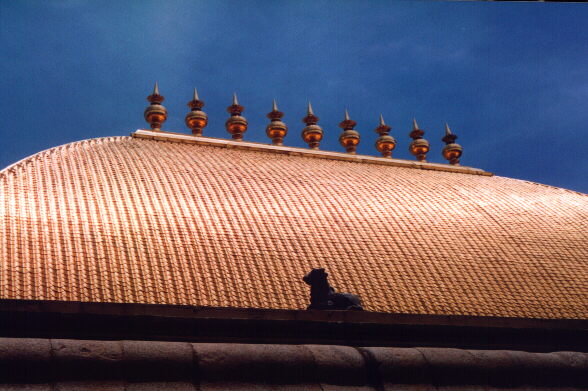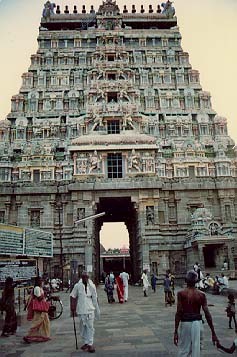The Chidambaram
Natarajar temple is a specimen of the assimilation of several architectural
styles. The innermost sanctum of the temple, houses the grand images of Shiva (Nataraja)
and Parvati (Sivakami) in the ChitSabha or the hall of
consciousness, adjoining which is the KanakaSabha or the Golden Hall,
both these structures resting on a raised platform. The innermost prakaram surrounds this
shrine, and to the South West of Nataraja, is the shrine of Govindaraja Perumaal facing the East.
The Chitsabha,
the holiest shrine in the temple, is a wooden structure supported with wooden pillars,
with a hut shaped roof. It is in this hall, that the images of Nataraja
and Sivakami are housed, in front of a set of two curtains, the inner
(invisible) one being red in color, the outer one being black in color.
To the right of Shiva,
is the revered Chidambara rahasyam - or a representation
of the concept of nothingness (space) garlanded with golden vilva leaves.
The curtain in front of the Chidambara Rahasyam, representing Shiva (and Parvati) in the
formless form (Aroopam) is lifted ceremoniously during worship services,
with offerings of lamps. Also in the Chitsabha are images of Ratnasabhapati
(Nataraja of Ruby), the Spatika Lingam of Chandramauleeswara,
Swarnakarshana Bhairavar, Mukhalingam etc.

The Golden Hall, or KanakaSabha
is immediately in front of the ChitSabha, both being on an elevated
platform as mentioned before, with silver panelled doors in front. The ChitSabha
itself is a meter or so higher than the Kanakasabha and is reached by a
flight of 5 silver plated steps, marking the five aksharas (or syllables) of the Panchakshara
Mantram (the five syllabled Namasivaya).
Across from the Nataraja
shrine in he second prakaram is the Nritta Sabha or the hall of dance
with some fine pillars, housing an image of Shiva in the Urdhva tandava posture,
winning over Kaali in a dance duel, and an image of Sarabheswara,
another form of Shiva (said to have quelled the ugra swaroopam of Narasimha).
The Nritta
Sabha with fine pillars is in the form of a chariot drawn by horses. The Deva
Sabha or the house of Gods is also in the second prakaram, housing festival
images of the Pancha Murtis (Somaskandar, Parvati, Vinayaka, Subramanya
and Chandikeswara) and other deities. Mulanathar, or the representation
of Shiva as a Lingam (Aakaasa Lingam) is housed in the second prakaram.
The outermost prakaram
is home to the grand Sivakami Amman temple, the Sivaganga
tank and the 1000 pillared hall or the Raja Sabha, where Nataraja is
brought during two annual festivals.
The vast Sivakami Amman
shrine is a temple in its own right. Ceilings on the mukhamandapam of this temple have
paintings from the Nayaka period. There are friezes of dancers, drummers and musicians all
along the enclosing walls of this temple.
The thousand
pillared hall has witnessed several grand events in history. This hall is also
designed in the form of a chariot. Its entrance features two elephants, and on the
basement there is a frieze of dancing figures. The 100 pillared hall, also in the
outermost prakaram is also of artistic value, as is the shrine of Subramanya,
which dates back to the Pandya period. The Subramanya shrine is also in
the form of a chariot, and is referred to as the 'Pandya Nayakam'.

Perhaps the most
magnificient structures in the temple are the four lofty gopurams or
towers in the four cardinal directions, piercing the walls of the outermost prakaram. Each
is a gigantic masterpiece in itself - about 250 feet in height, with
seven tiers. The Western tower is the oldest one.
In the towers, on
either side of the gateways there are representations of the 108 poses of the classical Bharata
Natyam Tradition as enunciated in the ancient treatise on dance - the Natya
Sastra. The towers are embellished with images from Indain mythology. From the
second tier onward, on each of the Gopuram, are seen images of various manifestations of Shiva such as Bhikshatana,
Kankala (both being ascetic forms), Kalyanasundarar, Somaskandar
etc. (bestowers of prosperity). There are no representations of Nataraja
on the temple towers, as this image is reserved for the innermost shrine alone.
